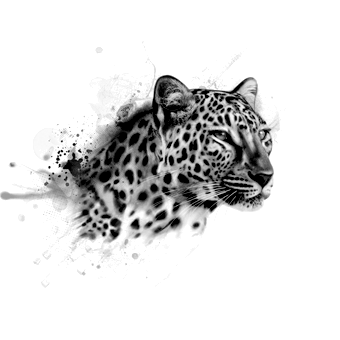‘Well, calling names won’t catch dinner,’ said the Ethiopian. ‘The long and the little of it is that we don’t match our backgrounds. I’m going to take Baviaan’s advice. He told me I ought to change: and as I’ve nothing to change except my skin I’m going to change that.’
‘What to?’ said the Leopard, tremendously excited.
‘To a nice working blackish-brownish colour, with a little purple in it, and touches of slaty-blue. It will be the very thing for hiding in hollows and behind trees.’
So he changed his skin then and there, and the Leopard was more excited than ever: he had never seen a man change his skin before.
‘But what about me?’ she said, when the Ethiopian had worked his last little finger into his fine new black skin.
‘You take Baviaan’s advice too. He told you to go into spots.’
‘So I did,’ said the Leopard. ‘I went into other spots as fast as I could. I went into this spot with you, and a lot of good it has done me.’
‘Oh,’ said the Ethiopian. ‘Baviaan didn’t mean spots in South Africa. he meant spots on your skin.’
‘What’s the use of that?’ said the Leopard.
‘Think of Giraffe,’ said the Ethiopian. ‘Or if you prefer stripes, think of Zebra. They find their spots and stripes give them per-fect satisfaction.’
‘Umm,’ said the Leopard. ‘I wouldn’t look like Zebra — not for ever so.’
‘Well, make up your mind,’ said the Ethiopian, ‘because I’d hate to go hunting without you, but I must if you insist on looking like a sunflower against a tarred fence.’
‘I’ll take spots, then,’ said the Leopard; ‘but don’t make ’em too vulgar-big. I wouldn’t look like Giraffe — not for ever so.’
‘I’ll make ’em with the tips of my fingers,’ said the Ethiopian. ‘There’s plenty of black left on my skin still. Stand over!’
Then the Ethiopian put his five fingers close together (there was plenty of black left on his new skin still) and pressed them all over the Leopard, and wherever the five fingers touched they left five little black marks, all close together. You can see them on any Leopard’s skin you like, Best Beloved. Sometimes the fingers slipped and the marks got a little blurred; but if you look closely at any Leopard now you will see that there are always five spots — off five black finger-tips.
‘Now you are a beauty!’ said the Ethiopian. ‘You can lie out on the bare ground and look like a heap of pebbles. You can lie out on the naked rocks and look like a piece of pudding-stone. You can lie out on a leafy branch and look like sunshine sifting through the leaves; and you can lie right across the centre of a path and look like nothing in particular. Think of that and purr!’
‘But if I’m all this,’ said the Leopard, ‘why didn’t you go spotty too?’
‘Oh, plain black’s best,’ said the Ethiopian. ‘Now come along and we’ll see if we can’t get even with Mr One-Two-Three-Where’s-your-Breakfast!’
So they went away and lived happily ever afterwards, Best Beloved. That is all.
Oh, now and then you will hear grown-ups say, ‘Can the Ethiopian change his skin or the Leopard his spots?’ I don’t think even grown-ups would keep on saying such a silly thing if the Leopard and the Ethiopian hadn’t done it once — do you? But they will never do it again, Best Beloved. They are quite contented as they are.

